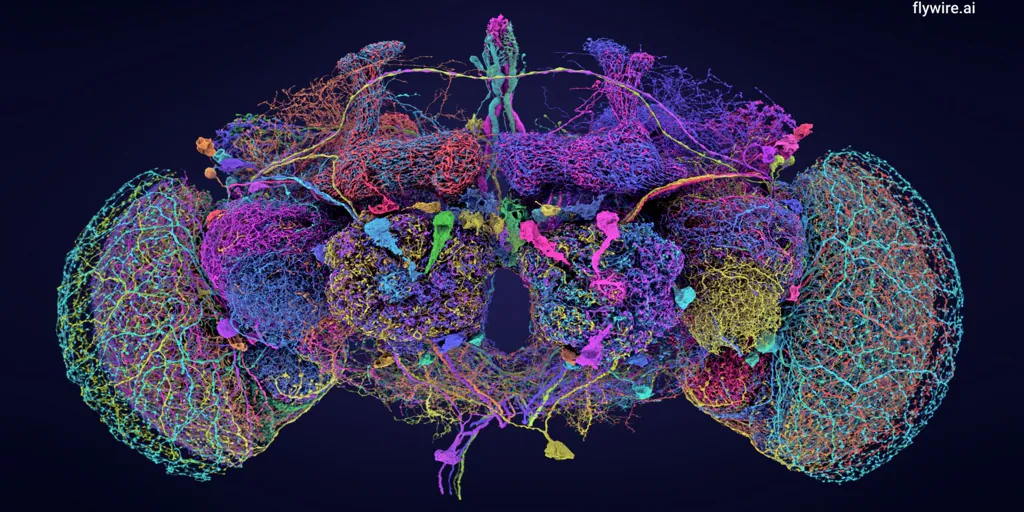Many of the most serious neurological diseases, such as dementia, Parkinson’s or Alzheimer’s, have no cure. Doctors can only treat the symptoms, because we do not yet understand the complexity of the human brain, with its billions of neurons connected by a hundred trillion synapses. A team of neuroscientists led by Princeton University has taken a key step towards understanding the entire framework that shapes our behavior, by building the first mapneuron by neuron and synapse by synapse, of the entire brain of an adult fruit fly (Drosophila melanogaster).
The new connectome, as this roadmap is called, shows in detail how the insect’s 139,255 neurons make approximately 50 million synapses. It is not the first time that researchers have built the complete connectome of a living being, but it is the first of a complex animal that can walk and see. Previously, the brain of a worm had been presented C. eleganswhich barely has 302 neurons, and that of a fruit fly larva, which has 3,000 and is yet to form. Both are much simpler. A ‘hemicerebro’ (a cerebral hemisphere) of the fruit fly was also known, which contained about 20,000 neurons connected by about 14 million synapses.
The complete diagram, described in nine scientific articles (1, 2, 3, 4, 5, 6, 7, 8 y 9) and featured on the cover of the magazine ‘Nature’ this Wednesday, was developed by the FlyWire Consortium, made up of 287 researchers from 76 laboratories around the world. The scientists cut the brain of the insect, an adult female, which measures less than a millimeter across, into 7,000 slices, each just 40 nanometers thick. These slices were scanned with a high-resolution electron microscope, obtaining 21 million images– More than 100 terabytes of image data, equivalent to the storage of 100 laptop computers.
The researchers used an artificial intelligence model created at Princeton to convert the bumps and spots in the images into a three-dimensional map. As the program is not infallible, all work was kept open to the scientific community from the beginning in order to correct errors and increase its accuracy.
It is an important achievement, says Mala Murthy, director of the Princeton Neuroscience Institute and co-leader of the research team. There is no other complete brain connectome of this complexity for an adult animal, he points out.
The fruit fly connectome contains a wide range of information, from cell types and synapses to neurotransmitters and network properties. Here, cells are color-coded according to the chemical messenger that defines them.
Like Google Maps
The researchers classified more than 8,400 types of cells in the fruit fly brain, of which 4,581 are new, allowing specific systems to be selected for further study, such as neurons involved in vision or movement. It also provides information about the type of neurotransmitter (chemicals such as dopamine or serotonin) secreted by each neuron. Likewise, the scientists tracked the organization of the hemispheres and behavioral circuits within the fly’s brain, such as the one that receives visual stimuli and produces changes that orient the body during flight.
It’s a bit like Google Maps -compares Philipp Schlegel, from the University of Cambridge-; The wiring diagram between neurons is like knowing which structures in satellite images of the Earth correspond to streets and buildings. Annotating neurons is like adding street and city names, business opening hours, phone numbers, reviews… to the map.
The 139,255 brain cells that make up the brain of an adult fruit fly. The activity of these cells drives the entire organism
Fruit flies may seem insignificant to us, but they are capable of surprisingly advanced cognition and behavior. For example, they can form long-term memories, engage in social interactions, and travel long distances. The males even sing to the females. That is why knowing your brain wiring is a first step to understanding everything that interests us: how we control our movement, answer the phone or recognize a friend, says Gregory Jefferis, from the MRC Laboratory of Molecular Biology, in Cambridge (United Kingdom). and co-director of the investigation.
Image showing the brain inside an adult fruit fly
neurological diseases
Fruit flies share 60% of human DNA and three out of every four human genetic diseases have a parallel in the insect. Javier Morante, senior scientist at the CSIC at the Institute of Neurosciences of Alicante, who has not participated in the study, is convinced that the work carried out with the fly, a model organism, will serve to better understand human neurological diseases that today have no cure. and other mental health problems.
The connectome of the fly larva represented how the brain was forming. Now we have an adult brain, already formed. If we compare it with a diseased brain or pathologies, we will be able to determine the altered mechanisms, suggests Morante. However, although this roadmap represents the brain of an organism with a very complex physiology, it is still very small, light years away from what it means to achieve the same thing with a mouse, which has millions of neurons, or a human being. .
The authors of the work believe that, now that the fruit fly connectome has been established, the same methodology could be used to quickly create similar maps in animals with larger brains. One step after another to finally know how ours works.
